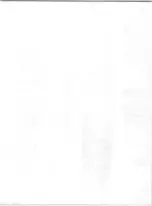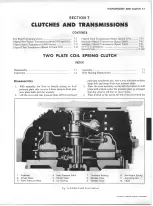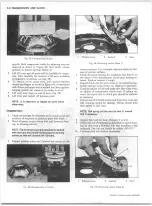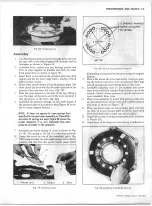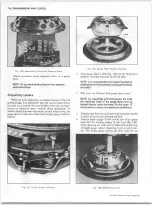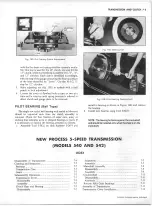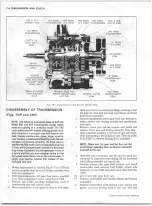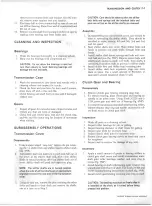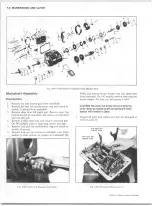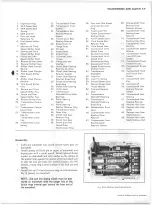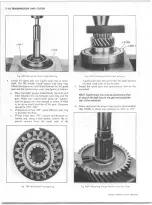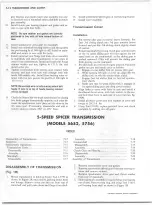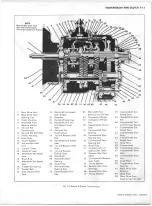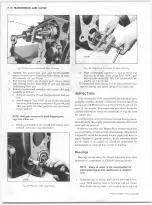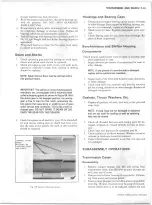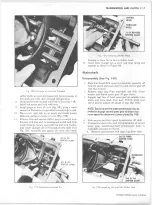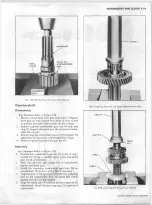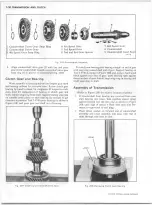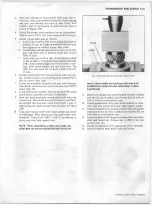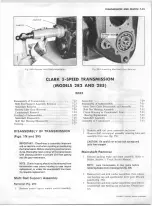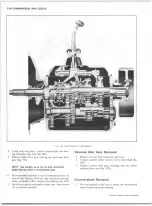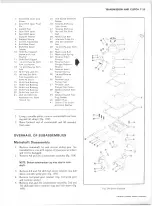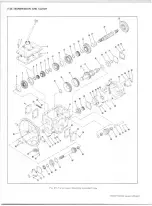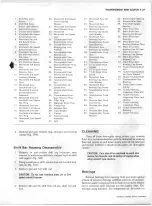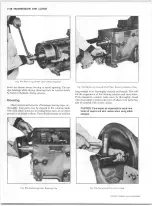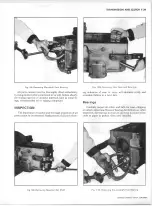
7-14 T R A N SM ISSIO N A N D CLUTCH
Fig. 2R~Removing M a in sh a ft Rear Bearing
6
.
Holding first-and-reverse gear and fourth-and-fifth
speed synchronizer to keep them from sliding off shaft,
lift assembly out top of case.
7.
Pick bearing rollers out of clutch gear, remove clutch
gear bearing retainer from front of case and tap gear
and bearing from case.
8
.
Remove countershaft assembly and reverse idler gear
assembly as follows:
a.
Remove countershaft rear bearing retainer and gas
ket.
b.
Install adapter Tool J-4761 in end of idler gear shaft
and using slide hammer as shown in Figure 4R, pull
idler gear shaft. Lift idler gear from case and remove
thrust washers.
NOTE: Hold gear horizontal to avoid dropping bear
ings from either end.
c.
Block countershaft from turning and remove coun
tershaft cotter pin, nut and washer.
Fig. 3R~Remove Idler Gear Shaft
Fig. 4R~Removing C o un te rshaft Rear Bearing
d. Slide countershaft assembly to rear to move rear
bearing out of case. Then using Tool J-8107, pull
bearing from shaft (fig. 4R). Lift countershaft as
sembly out top of case.
If countershaft front bearing is to be removed from case,
tap out bearing and spacer (plug) from inside case.
IN SP EC T IO N
Prior to assembly of the transmission, the individual parts
should be carefully checked to eliminate those damaged from
previous service. Broken parts are often the result and not the
cause of the trouble. This inspection procedure should be
carefully followed to ensure the maximum of wear life from
the rebuilt unit.
All components of the transmission (except bearing assem
blies) should be thoroughly cleaned with cleaning solvent and
dried with air pressure.
Whenever available, the Magna-Flux method should be
used on all parts, except ball and roller bearings. This method
is especially suited for detecting minute cracks and wear on
highly finished or ground surfaces, which otherwise would
not be visible to the naked eye. Check all components for
discoloration or warpage due to heat or binding.
Bearings
Bearings should always be cleaned separately from other
transmission components in CLEAN cleaning solvent.
NOTE: Steam or water is not recommended for
cleaning bearings as they usually rust in a very short
time.
1.
Slush bearings in solvent until all old lubricant is loos
ened. Hold bearing races so bearings will not rotate;
then brush bearing with a soft bristled brush until all
CHEVROLET OVERHAUL M A N U A L SUPPLEMENT
Summary of Contents for 40 60 Series
Page 1: ...40 60 SERIES TRUCK SUPPLEMENT ST 334 72...
Page 86: ......
Page 96: ...n 47 k u m i i i iin I ll II I...
Page 222: ......

